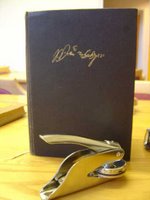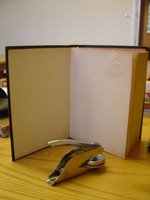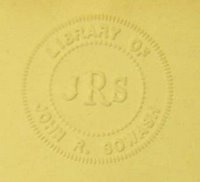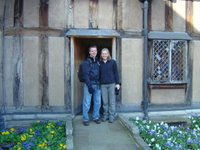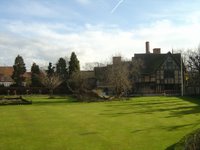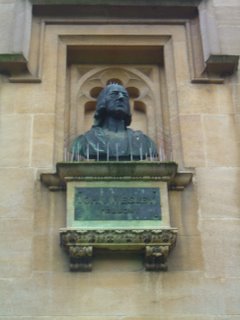Note: The following post is comprised of excerpts from my latest essay for Dr. Emma Plaskitt, C.S. Lewis tutor at the University of Oxford. Lewis on Marriage: A Critical Analysis of Marital Themes in
That Hideous Strength and Other Works by the Author.
C.S. Lewis’ book That Hideous Strength revolves around Mark and Jane Studdock, two newlywed characters who find themselves involved in a cosmic battle between good and evil. Their relationship with one another and their ideas on matrimony and family provide an interesting secondary storyline and reveal some of Lewis’ thoughts, opinions, and biases about marriage. When coupled together with the apologetic works and epistolary collection of Lewis, it is possible to gain a fairly complete picture of the author’s views on matrimony.
The very first word in That Hideous Strength is Matrimony. Accordingly, it is a reoccurring subject throughout the novel. Jane and Mark Studdock had only been married six months when the reader is first introduced to them. Their ideas and hopes about marriage had not been sustained as they had dreamed. In the first chapter, Mark Studdock questions his marriage: “But now…why had he married her? Was he still in love? If so, ‘being in love’ must mean very different things to men and women” (Hideous 2). From this point forward the gap between Jane and Mark increases; both geographically as they are rarely together in the story and emotionally as they pursue different concepts of truth.
The relationship between Jane and Mark is better understood if the views of the author are known. Lewis, in a letter to former pupil Mary Neylan, outlined what he thought were the three primary purposes for marriage:
1. To have children.
2. To provide a proper sexual outlet.
3. To help and care for your spouse (Hooper 392).
Each of the three purposes for marriage is illustrated in That Hideous Strength. They are also spoken about in Lewis’ apologetic and scholarly works. As That Hideous Strength is simply an outpouring of what was already firmly rooted in Lewis’ mind, it should be accepted that these were also his personal views on marriage. This hypothesis is confirmed through a study of his unambiguous Christian writings.
At this point, it is essential to make one concession on Lewis’ philosophy of marriage: he was unmarried when That Hideous Strength was published. Without question he was speaking from inexperience. That Hideous Strength was published in 1945, but Lewis remained single until 1956 when he married Joy Davidman. David Downing, speaking on Lewis’ portrayal of marriage in That Hideous Strength wryly commented that “Perhaps it would have been wiser for an unmarried person to speak more tentatively on this topic” (150). This is not to say that an unmarried man must never speak on the subject of marriage anymore than a British person should not be allowed to speak about America. However, it is fair to say that his writings were very idealistic. Lewis understood he was speaking from ignorance, as he freely wrote in Mere Christianity (104). He was very reluctant to include a chapter on Christian marriage, yet felt compelled to do so as it was such an important issue. The portrayal of marriage by Lewis is by no means an authoritative one; however his wisdom and clarity in so many other areas of life make him worthy of a hearing.
When Jane and Mark are placed against Lewis’ “marriage laws” they fail on all three accounts. First, they never intended to raise a family, they were far more concerned with their careers. The second point of marital failure, sexual intercourse, is subtly absent in That Hideous Strength. Their obvious rejection of reproduction adds further evidence to their chastity. Lewis’ third purpose for marriage, the help and care of your spouse, was also poorly fulfilled by the Studdocks. The couple is rarely together throughout the course of the story and therefore unable to meet one another’s physical and emotional needs. Jane commented that “…she had never seen so little of Mark as she had done in the last six months” (2). If two people never or rarely see one another, it is very difficult for them to be involved in their lives and to help their spouse. Lewis believed that all three features are essential to a strong marriage. No wonder Mark and Jane had so much trouble.
During the course of his career, Lewis wrote extensively on the subject of love. In Mere Christianity, Lewis devoted an entire chapter to the subject of “Christian Marriage.” In it, he reminds his readers that
“Being is love is a good thing, but it is not the best thing. There are many things below it, but there are also things above it. You cannot make it the basis of a whole life. It is a noble feeling, but it is still a feeling” (108).
The relationship between Mark and Jane is by no means a “Christian Marriage.” Lewis contrasts them against the ideal, showing, in his mind, the result of a marriage devoid of God’s principles. Without a deeper commitment to a marital relationship than “love,” couples are doomed to unhappy lives destined for divorce.
That Hideous Strength is a novel about the battle between good and evil. The background to that story is a young couple slogging through marriage difficulties. Through their struggles and failures, they emerge wiser and closer than they ever would have without the adversity they experienced. Lewis provided a glimpse of marital failure and reconciliation as an example for his readers. The relationship between Mark and Jane also reveals the essential need of love, sacrifice, and humility.
------------------------------------------------------------------
Bibliography
Collins, Owen, ed. To Quote C.S. Lewis. London: Harper Collins, 2000.
Downing, David G. Planets in Peril. Amherst: Univ. Mass. Press, 1992.
Hooper, Walter, ed. The Collected Letters of C.S. Lewis. Vol. II. New York: Harper Collins, 2004.
Lewis, C.S. Mere Christianity. London: Harper Collins, 2002.
Lewis, C.S. That Hideous Strength. London: Harper Collins, 2005
Lewis, C.S. The Abolition of Man. London: Centenary Press, 1946.
Lewis, C.S. The Four Loves. London: Harper Collins, 2002.
Schakel, Peter J. ed. The Longing for a Form. Kent State UP, 1977.
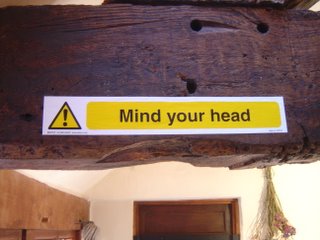
 Good night....more to come later!
Good night....more to come later!
